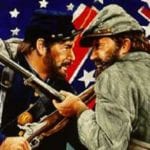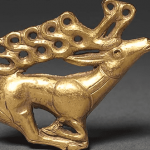 Our World
Our World  Our World
Our World  Pop Culture
Pop Culture 10 Incredible Female Comic Book Artists
 Crime
Crime 10 Terrifying Serial Killers from Centuries Ago
 Technology
Technology 10 Hilariously Over-Engineered Solutions to Simple Problems
 Miscellaneous
Miscellaneous 10 Ironic News Stories Straight out of an Alanis Morissette Song
 Politics
Politics 10 Lesser-Known Far-Right Groups of the 21st Century
 History
History Ten Revealing Facts about Daily Domestic Life in the Old West
 Weird Stuff
Weird Stuff 10 Everyday Products Surprisingly Made by Inmates
 Movies and TV
Movies and TV 10 Actors Dragged out of Retirement for One Key Role
 Creepy
Creepy 10 Lesser-Known Shapeshifter Legends from Around the World
 Our World
Our World 10 Science Facts That Will Change How You Look at the World
 Pop Culture
Pop Culture 10 Incredible Female Comic Book Artists
 Crime
Crime 10 Terrifying Serial Killers from Centuries Ago
Who's Behind Listverse?

Jamie Frater
Head Editor
Jamie founded Listverse due to an insatiable desire to share fascinating, obscure, and bizarre facts. He has been a guest speaker on numerous national radio and television stations and is a five time published author.
More About Us Technology
Technology 10 Hilariously Over-Engineered Solutions to Simple Problems
 Miscellaneous
Miscellaneous 10 Ironic News Stories Straight out of an Alanis Morissette Song
 Politics
Politics 10 Lesser-Known Far-Right Groups of the 21st Century
 History
History Ten Revealing Facts about Daily Domestic Life in the Old West
 Weird Stuff
Weird Stuff 10 Everyday Products Surprisingly Made by Inmates
 Movies and TV
Movies and TV 10 Actors Dragged out of Retirement for One Key Role
 Creepy
Creepy 10 Lesser-Known Shapeshifter Legends from Around the World
10 Terrible Realities of Life at Sea in the Golden Age of Sail
Seeking thrills? Embark on a maritime journey and unearth exotic realms. The untold riches of the new world await!
Enticing promises like that lured sailors during the Age of Discovery. Sometimes known as the Golden Age of Sail, it was a period from the 15th to the 17th century. European vessels embarked on global expeditions in pursuit of treasure. Explorers mapped out previously uncharted trade routes. Governments waged unspoken wars in the battle for territorial dominance in the New World.
Portuguese navigators pioneered this worldwide expansion. They ventured into the Orient, Africa, and later the Americas. Soon, other European powers followed. They sent their sailors on years-long, incredibly dangerous voyages. These men embarked on perilous odysseys. Many did so by bidding farewell to their homelands forever. Their ventures carried the ominous specter of gruesome fatalities. Plus, plenty were complicit in the subjugation and enslavement of indigenous peoples. It was brutal all around.
So today, we take a look at ten ways life at sea really sucked during the Age of Discovery. Historians may know it today as a golden age of exploration and adventure. But the truth is that era was remarkably difficult for the average sailor. Here’s why…
Related: 10 Punishments Of The Royal Navy During The Age Of Sail
10 Life without GPS
The year was 1492 when Christopher Columbus embarked on his famous voyage across the Atlantic. But let’s set the record straight: He didn’t actually discover America. That credit goes to Viking leader Leif Eriksson. He arrived in modern-day Newfoundland half a millennium earlier. Nevertheless, Columbus’s journey wasn’t without its own misadventures.
Armed with primitive navigation tools and limited knowledge of astronomy and trade winds, Columbus and his crew found themselves profoundly lost. Their voyage spanned an astonishing 4,000 miles of uncharted water. It was a testament to the audacity and risks of early exploration. It was also nearly a colossal mistake that ended in sure disappearance.
After a grueling 36 days at sea, Columbus finally set eyes on land. He figured it was India. Little did he know that he had stumbled upon the Bahamas. The native people he encountered there were henceforth forever mistakenly labeled “Indians.” This misnomer would later extend to encompass all indigenous populations of the Americas.
So, while Columbus may not have been the first to reach America, his inadvertent encounter with the New World would forever alter the course of history. And he did it all without GPS. Would you have had the patience to sit on a boat for more than a month without knowing exactly where you were going or how to get there?[1]
9 The Terror of Scurvy
Eating fresh fruits and vegetables is a lesson ingrained in us from an early age. But imagine being a sailor in the past, where life at sea meant bidding farewell to these essential dietary staples. This led to a fatal condition known as scurvy, aptly nicknamed the “scourge of the seas.”
Between the 16th and 19th centuries, scurvy claimed the lives of over two million sailors. It’s a startling fact that scurvy caused more deaths at sea than violent storms, treacherous shipwrecks, deadly combat, and all other diseases combined. The consequences of scurvy were nothing short of horrifying. Today, think of them almost akin to grotesque scenes out of The Walking Dead.
Scurvy wreaked havoc on the body, both internally and externally. Arteries and capillaries decayed gradually, leading to a slow disintegration. The afflicted sailors suffered from painful ulcers, terrifying seizures, and breaks in their skin. It was a relentless assault on their bodies, a degradation that marked the unfortunate souls who suffered from this malady.
Interestingly, the British Navy took a notable step to combat scurvy. They began supplying sailors with limes, which earned them the nickname “limey.” This simple addition of vitamin C-rich limes to their diet proved instrumental in preventing scurvy and safeguarding the health of the British naval forces. It wasn’t perfect, but it worked better than anything before it. Eventually, along with other food preparation advancements, some of the concerns around scurvy slowly subsided.[2]
8 Awful Weather
Traveling by boat is no walk in the park. Sorry for mixing metaphors there, but the waves are tough on travelers—especially those prone to motion sickness. It often leads to the unpleasant experience of projectile vomiting. But with no other viable options for crossing the Atlantic, sailors back then had no choice but to endure the hardships that came with it. Of course, that included treacherous weather conditions like hurricanes, freezing temperatures, and massive rogue waves.
In the Caribbean, catastrophic storms would frequently turn the waters into a vast graveyard. Countless old Spanish Galleons filled with valuable treasures sunk to the bottom because of unpredictable bad weather. Without radar or weather maps back then, nobody really knew when terrible storms would strike. Every sailor—and every ship—put their lives in the hands of the sea each time they went out on a voyage. More often than anyone cared to admit, they never came home.
Still today, modern-day shipwreck hunters continue to discover gold off the coast of Florida. The most notable haul originated from the famous 1715 treasure fleet that was en route from the New World to Spain. On July 31, 1715, a powerful hurricane unleashed its wrath. It sent 11 of the fleet’s 12 ships to their watery graves. Sadly, this disaster claimed the lives of 1,500 sailors. That was a bit of an exceptional tragedy, of course. But beyond it, plenty of other storms in those difficult sailing centuries claimed the lives of countless men.[3]
7 Pressed and Crimped
During its quest for global dominance, the British Empire granted the Royal Navy the power to forcefully recruit individuals into military service. That practice was known as impressment. This ugly practice goes all the way back to Elizabethan times. Then, “press gangs” were employed to round up vagrants in English towns. The men were forced to fill the crews of ships… whether they wanted to or not.
While the minimum age for joining the Navy was 16, some boys as young as 7 or 8 were pressed into service as “powder monkeys.” These youngsters played a crucial role in a hazardous job: They ferried gunpowder from the ship’s hold to the artillery weapons. Officers favored them for their agility and ability to navigate cramped spaces more swiftly than adults.
Over time, the press gangs were replaced by crimps. This was an unscrupulous group that coined the term “shanghai’d” for kidnapping men sent on voyages to the Chinese port city. This nefarious practice thrived in English port cities like London and Liverpool.
It even took hold on the West Coast of the United States. Portland, Oregon, eventually became the world’s “shanghaiing” capital. The city boasted an intricate network of underground tunnels situated below bars and cheap lodgings. Here, unsuspecting men would be enticed into a night of heavy drinking only to awaken on a ship far from their homes.[4]
6 Slavery
During the late 15th century, nearly 11 million Africans were enslaved by European sailors. These captives were subjected to unimaginable hardships over the next four centuries. European powers built colonies in the Americas on the backs of this forced labor.
The journey of enslaved Africans began with their transportation on slave ships. Deep down in the ships, they were confined in shackles. The vessels were plagued with bacteria and emitted a putrid stench. When they embarked, the treacherous voyages lasted up to two months. Known as the middle passage, this perilous journey across the Atlantic Ocean claimed countless lives. Harsh weather, inhumane conditions, and rampant diseases were consistent killers. Some desperate captives even chose to jump overboard. For those men and women, death was better than the horrific voyage.
The establishment of massive plantations in the New World necessitated an extensive workforce. Thus, it perpetuated the relentless cycle of the transatlantic slave trade. European powers prioritized empire-building at the expense of human lives. Enslaved Africans endured untold suffering in their forced labor. The sailors who ferried them across the sea were party to those atrocities too. Regardless of how they felt about it, they were forced to take part. It was no place for a conscience. Thus, even today, the middle passage remains a dark mark on human history.[5]
5 Subjugation
Thanksgiving is a cherished American tradition. Families gather to give thanks, enjoy a feast, and watch as much football as they can handle. We’re supposed to use the holiday to thank each other and our community for living in such a great land. And many Americans who celebrate it often think back to the first-ever Thanksgiving too. Yes, it originated as part of the Pilgrims’ first harvest in Plymouth, Massachusetts, in the 17th century. The migrating Pilgrims were right there alongside indigenous tribes, and then held a meal for all of history.
However, harmony faded fast. Native Americans and the newcomers clashed throughout the end of the Age of Sail and well beyond it. These New World clashes led to violence, distrust, and terribly deadly diseases. Epidemics like smallpox and measles ravaged the indigenous population. Some historians now believe these diseases claimed at least 75% of indigenous lives throughout North America after the 17th century.
Sadly, smallpox and the other diseases spread easily and wiped out those without immunity. Moreover, the loss of tribal elders meant the loss of knowledge and traditions. That continues to have devastating consequences for future generations that persist now. And it all started with groups of Pilgrims—and other sailors—riding high into the New World to conquer and dominate.[6]
4 Sudden Violence
Magellan, Cook, and Ponce de Leon are among many renowned figures whose names are etched in history. However, their journeys ended tragically at the hands of indigenous peoples they encountered along the way. And like them, many other explorers met awful fates upon reaching their eventual destinations. As it turns out, native peoples didn’t always care for outsiders showing up and rudely trampling everything. Who knew?
Ferdinand Magellan, despite his groundbreaking circumnavigation, met his demise in the Philippines. Struck by a bamboo spear, he never completed his momentous voyage. Similarly, Juan Ponce de Leon’s quest for the mythical Fountain of Youth in Florida was cut short by a poison arrow from the Calusa warriors in 1521.
Captain James Cook, the daring British navigator, met his fate in the beautiful Hawaiian Islands. While mapping the South Pacific, Cook found himself embroiled in an ill-fated attempt to abduct the ruling chief named Kalani’opu’u. Sadly, the captain’s audacious plan proved fatal. He took his last breath in paradise and then became the focus of centuries of notorious stories about it.
Ultimately, these tales serve as a somber reminder that exploration comes with significant risks. While these explorers left an indelible mark on history, their encounters with hostile natives sealed their tragic destinies. They also served as important lessons for other sailors of the time, too: Along with great adventure, exploring the high seas and going off into the unknown came with great risk.[7]
3 Living with Rats
During the 1700s, rats were a notorious problem on English and French ships. Vessels taking part in the colonization of North America were relentlessly plagued. These pesky rodents infested ships all across the Golden Age of Sail. They snuck aboard in ports during the loading and unloading of goods. Once aboard, they multiplied rapidly in the ship’s holds. Then, they gnawed through food supplies and caused general havoc.
Crew members faced the greatest risk from the diseases transmitted by rats. The cramped conditions below deck made it easy for direct contact with rat saliva, urine, or feces. There was plenty of indirect contact through contaminated food storage too. Moreover, rats carried fleas that acted as disease vectors. Those tiny bugs spread even more dangerous illnesses like bubonic plague, typhus, and spotted fever.
Above all, rats were one of the most annoying daily occurrences that made up the sailor’s lifestyle. They were relentless in what they did on board ships, and it seemed like they got into every little nook and cranny. Things got so bad, in fact, that vessels eventually started carrying cats along for rides just so that they could hunt and eat rats as they pleased. In turn, that became a decent solution to a major pest problem.[8]
2 Brutal Consequences
Living conditions for sailors in the past were far from pleasant. They endured cramped and foul-smelling quarters, often had to survive on spoiled or scarce food, and worked grueling shifts non-stop. As if that wasn’t enough, these unfortunate men had to endure the cruel treatment of sadistic officers who took pleasure in enforcing discipline. These conditions sometimes pushed sailors to the brink, resulting in mutiny, as was the case with the famous explorer Henry Hudson. Many other explorers and ship captains also learned this lesson the hard way: Take punishment too far, and sailors will rebel in a murderous rage.
Punishments were particularly harsh on board merchant ships. Flogging was the most common form of discipline. In that era, it took on a savage twist known as “kissing the gunner’s daughter.” This involved tying the offender to a cannon—which was referred to as the gunner’s daughter—and relentlessly whipping them with a nine-tailed whip known as a “cat o’ nine tails.” In even more brutal instances, crew members could be tied to a rope and dragged beneath the ship in a horrifying process called keelhauling.
In the most extreme cases, sailors faced the grim fate of being hanged to death. Mutiny was a hangable offense, often leading to immense suffering for those caught conspiring. The hardships and punishments endured by sailors during this era were truly grueling. Soon, they became the stuff of legend. Even today, we regard them as draconian, difficult, and dangerous.[9]
1 Smoking Like a Chimney
Cigarette smoking is responsible for nearly half the deaths caused by all types of cancer. It severely affects organs, including the liver, colon, rectum, lung, throat, esophagus, larynx, stomach, pancreas, bladder, kidney, and cervix. Major anti-smoking initiatives have taken place in recent decades. But the habit has been around for a long, long time. Interestingly, this harmful practice was introduced to the world during the Age of Exploration.
When Christopher Columbus arrived in the Caribbean, he was presented with dry tobacco leaves by the locals of San Salvador. Unaware of their purpose, Columbus discarded them into the sea. However, he soon discovered their value in trade. Other European explorers learned of their importance, too, and many soon began cultivating the highly addictive and lucrative cash crop.
Before long, smoking became a widespread habit on ships and back in Europe. Cigarettes, cigars, and pipe tobacco gained popularity worldwide. On board ships, sailors smoked like proverbial chimneys, as well. This made for certain dangers inherent to the era of wood-built vessels. But beyond that, the long-term health impacts were detrimental, too—if sailors lived long enough to make it through their next voyage and experience lasting issues, that is.[10]








